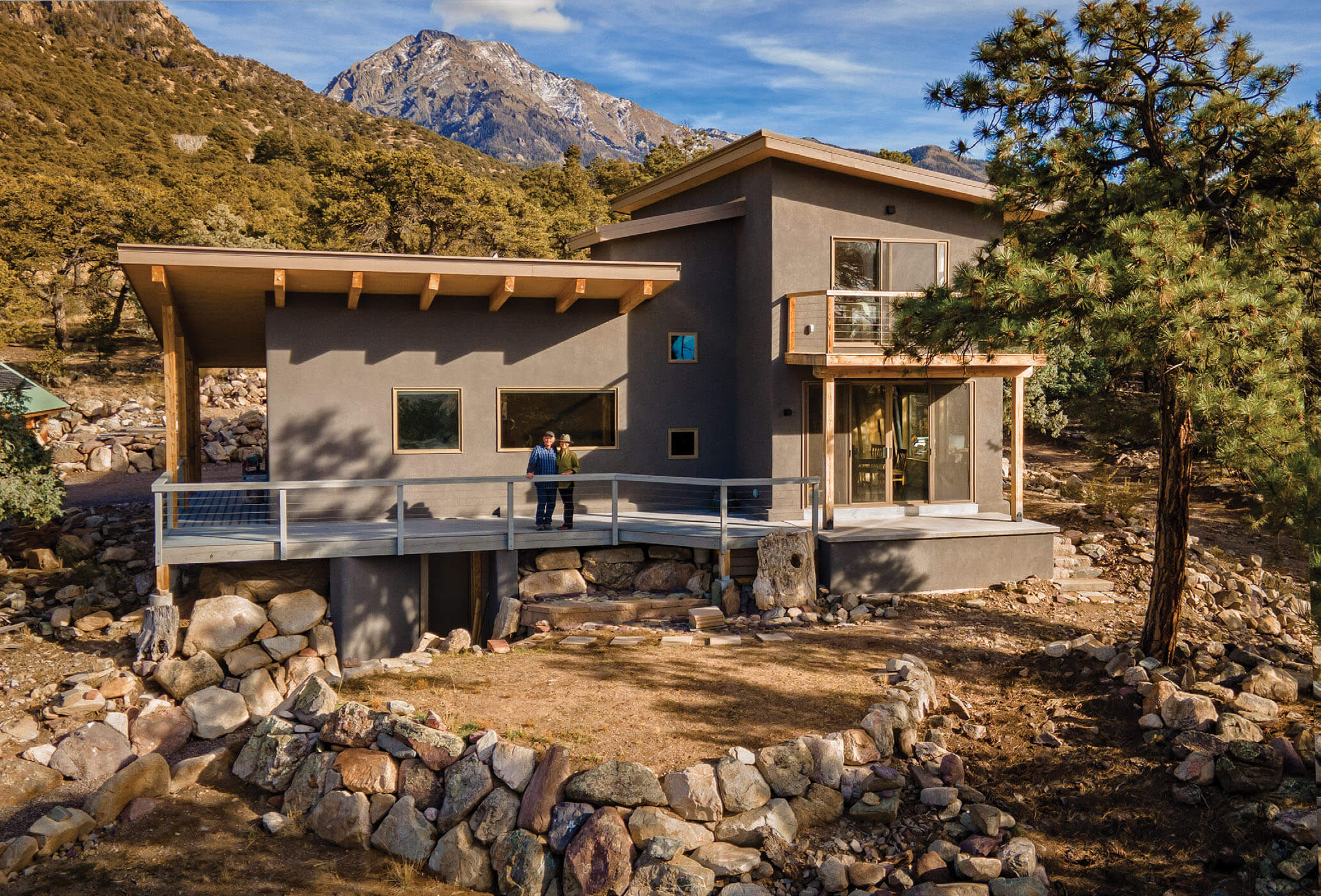
04 Jan In the Studio: Clay and Cameras
Sculptor Amy Laugesen and visual artist Stephen Hume met, appropriately enough, in a Denver art gallery. They started dating in 1999 and married three years later on the winter solstice.
The artistic couple built their dream home off the grid in Colorado’s vast San Luis Valley five years ago. “It’s the largest alpine valley in the world. The valley runs almost to Taos, New Mexico,” says Hume, who purchased roughly 20 rugged acres in the ‘80s. A native of Idaho, he discovered the legendary valley serendipitously while traveling to the Telluride Film Festival.
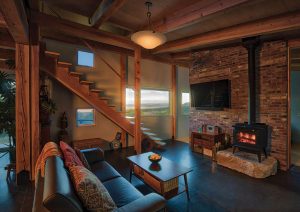
A wood-burning stove and radiant floor heating warm the couple’s cozy home. They rely upon well water, a solar photovoltaic system, a leach field, and a septic system. Photo: Stephen Hume
“I wandered, thinking I’d like to buy property,” he says. “I found a piece east of town. I was very ungrounded, and I saw a big ponderosa pine and realized that I needed to be rooted, and I needed to be custodian to this tree.”
Above all, Hume was inspired by the magnificent views. The couple’s home has views across the valley to the San Juan Mountains, Kit Carson Mountain in the Sangre de Cristos, Crestone Creek, and the town of Crestone. Additional motivations included the fresh mountain air; the dark skies conducive to his passion for photographing the Milky Way; and Crestone’s multicultural outposts.
“Crestone is a spiritual mecca,” says Hume.
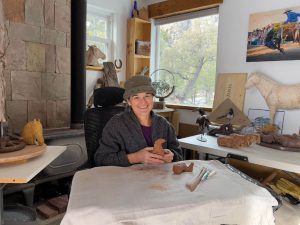
Laugesen, a sculptor known for her ceramic horses with signature glazes, respects the history and heritage of her subjects, as well as the animal’s curvilinear lines.
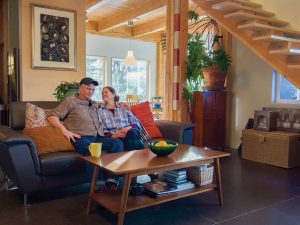
The artists relocated from Denver to the solace and inspiration of the home they built in the San Luis Valley.
Before meeting his wife, Hume regularly visited the area. “I’d come up and camp and spend time here every month,” he says. “Then Amy and I did a lot of high-end camping here.”
About 20 years ago, the couple had a studio built on the site about 50 feet downhill from where they subsequently built their house. “The studio is very simple but cozy. We added a wood stove, so it’s comfortable,” Hume says. “Amy can go down there all day long and dink around. She likes her peace and quiet.”
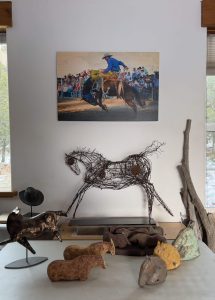
Hume’s rodeo photography and Laugesen’s horse sculptures reflect their Western environment.
Laugesen says, “We’ve always called it ‘the studio,’ even when it was the place we stayed — especially Stephen — during the build. It’s 16 by 16 — like a tiny house.”
The sculptor values the simplicity of the space, furnished only with her sculpting stand plus a table and a futon. Laugesen hopes to add a wood-burning kiln for ceramic firing.

For the artists, the objects and textures of their rural setting inspire creativity. Photos: Bill Ellzey
“It’s a place to focus without distractions. There’s a quiet and a calm here that helps settle the mind,” she says of the studio.
“There’s no electricity, no running water. We’re pulling that from the house when needed, or we have solar batteries,” she adds. “Beautiful natural light comes in huge barn doors added by design, so the studio can be opened to the south and bigger works can be rolled in and out.”
When the couple decided to branch out from the studio and build their home, Hume climbed trees to determine how high their deck needed to be to see craggy Kit Carson Mountain. They situated their two-story, 2,000-square-foot house upslope on the property for optimum views of the mountain and valley.
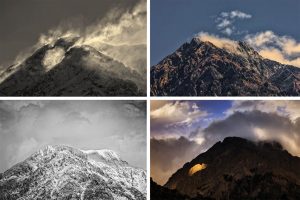
Hume’s series of 101 photos of the changing moods of Kit Carson Mountain document dramatic weather patterns. Some locals refer to the mountain as Crestone Peak, one of the 14ers in Southern Colorado’s Sangre de Cristos. Photos: Stephen Hume
Hume’s studio in a corner of the house provides him with relative darkness for his monitors. But for his current project — 101 photographs of the moods of Kit Carson Mountain — he keeps a camera set up on a tripod.
“We have a sliding glass door right off my studio, and it could be 14 degrees below zero, but all I have to do is open the door and snap,” he says. “The weather is so transitory, so I leave it set up.”
As for Laugesen, the peaks and San Juan Valley shape her sculptures. Celebrated for her compelling horses — both studio-sized and large-scale outdoor installations — Laugesen sees a seismic shift in her sculptures. “The awe of the landscape that surrounds us: I’m definitely starting to percolate, and my work is responding sculpturally to the landscape,” she says. “I’m doing more groupings. I’ve done herds before, but I’m really responding even more to the mountains and the horizon lines coming together.”
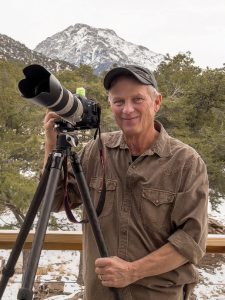
Hume shoots both still photography and video. He currently focuses on Kit Carson Mountain, pictured behind him. Photo: Bill Ellzey
For Laugesen, the expansive environment influences her work, as well as her state of mind. The sculptural mountains inspire her. “I feel pretty small in the valley. As a sculptor, I can’t compete with the scale. The peaks around us and the trees put life into perspective. It’s dramatic and humbling. There’s such a physicality to these landmarks, and I’m watching that unfold in my work. I’m constantly on the search for the line of the horse, and I see them in the mountains, the clouds, and the landscapes.”
The sculptor also sees the appealing patina of age resulting from exposure to Colorado’s intense elements in her rural surroundings. The authentic grit resembles her signature ceramic glazes that look as if they could be antique or even ancient.

The artists often begin their days sitting together in meditation. Photo: Bill Ellzey
“I see the relics of old homesteads, and I’m inspired by those artifacts: the wood of fence posts and old barns wearing down, the rusted wire of old fencing. There’s a romance, but also a sense of those that came before us,” she says. “I really resonate with all of that.”
Life in the picturesque valley has also influenced her color palette. “I’m using more glazes with blue and indigo from the mountains and the skies. More golden colors, sage green and the green of the piñons, the color of the sand dunes, along with the rust that has a sense of antiquity worn and weathered from the harshness of the conditions, which I love,” she says.
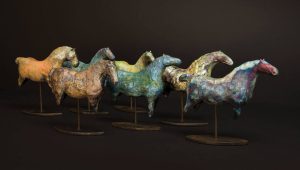
Living in the vast, rural San Luis Valley inspired Laugesen to sculpt more herds of horses.
As husband and wife, the couple supports one another’s artistic endeavors. He photographs her sculptures and sometimes assists with mounting them onto mixed-media platforms. She lends a hand with lighting when he’s photographing the Milky Way or other subjects.
And the two aim to start their mornings by sitting together in meditation. Their Zen practice rewards them with tranquility, trust, and a true sense of gratitude for their shared life of love and art, clay and cameras, horses and mountains: the best of the American West.
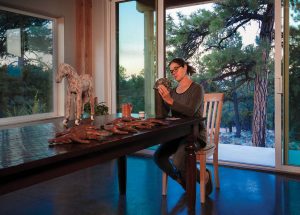
Though the property includes a studio separate from the house, during the winter months, Laugesen often works in the natural light of the couple’s living room. “Amy was the reluctant pioneer, but now that she’s totally adapted, she’s just a pioneer, not reluctant,” says Hume. Photos: Stephen Hume
Colleen Smith — an award-winning author, journalist, and filmmaker based in Denver, Colorado — writes about fine art, popular culture, and the American West for a number of publications.






No Comments